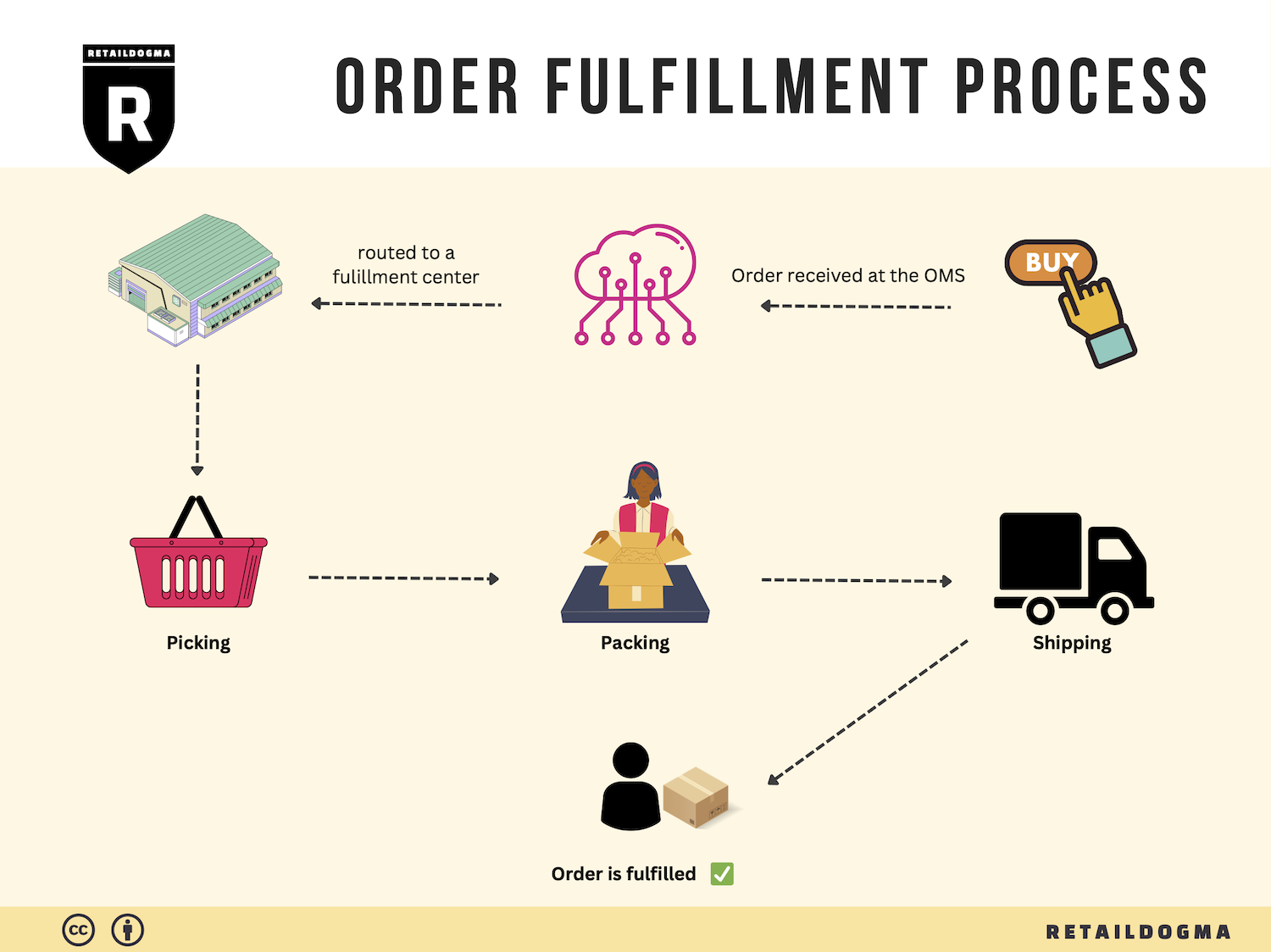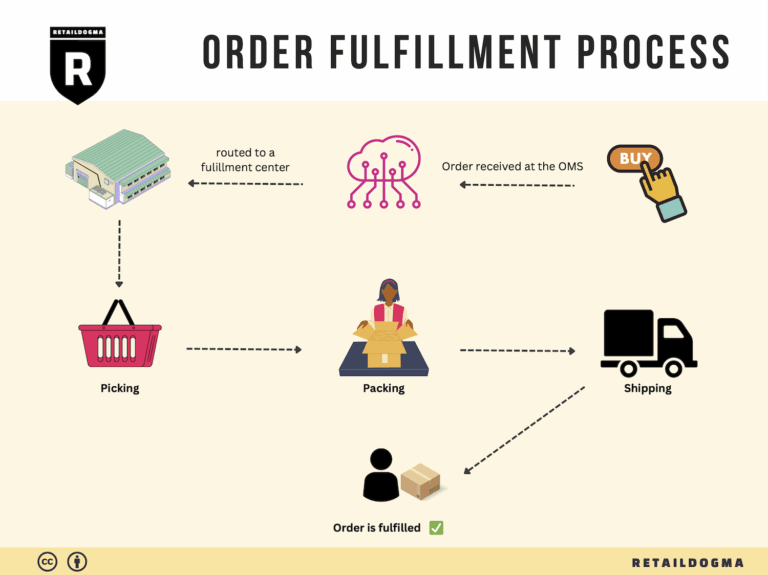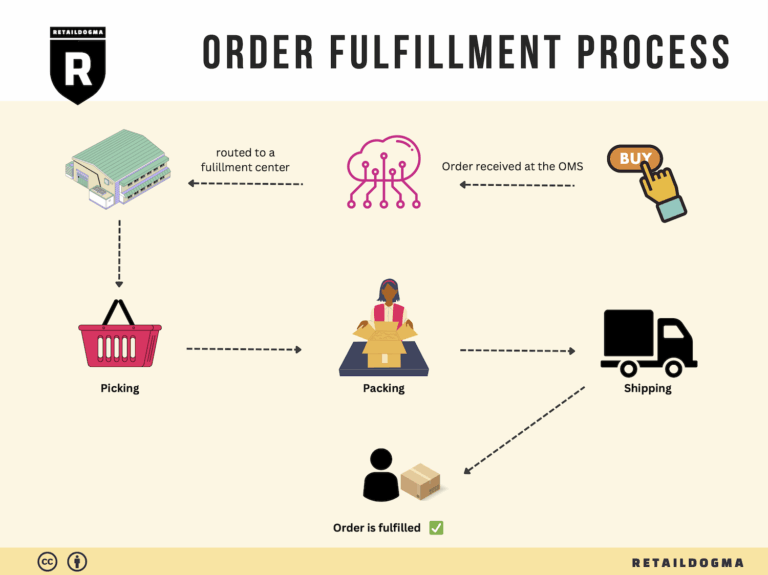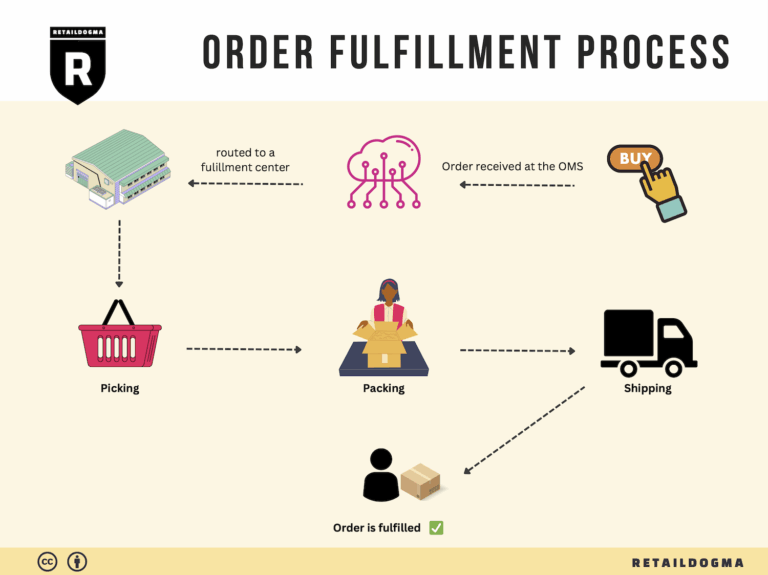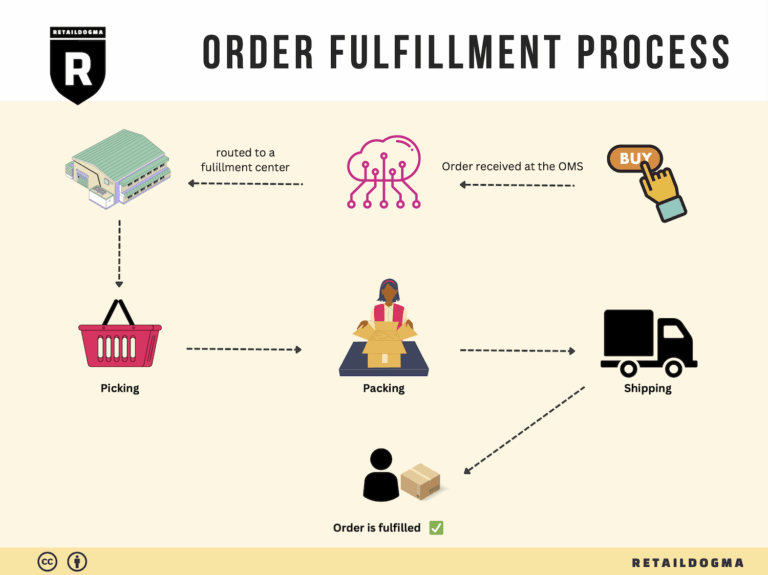What Is A Fulfillment Center? A Complete Guide (2025)
What is E-commerce Fulfillment? An Introduction for Growing Businesses
As an e-commerce business grows, the excitement of increasing sales can quickly turn into the stress of managing order fulfillment. Many entrepreneurs find themselves overwhelmed by the logistics of packing and shipping orders, leaving them little time to focus on scaling their operations or enhancing customer relationships. This is where the concept of e-commerce fulfillment becomes crucial.
Understanding Fulfillment
E-commerce fulfillment is simply the process of getting a product from your inventory to your customer’s doorstep. It involves several key steps, including receiving inventory, storing products, picking and packing orders, and finally shipping them to customers. For growing businesses, mastering this process is essential to meeting customer expectations, especially as consumers demand faster and more reliable delivery.
What This Guide Covers
In this guide, we will explore various fulfillment models that can support your business as it scales. You’ll learn about options like Third-Party Logistics (3PL) and Fulfillment by Amazon (FBA), each offering unique benefits and services tailored to different business needs. We will delve into the core services these partners provide, which may include inventory management, order processing, and customer service support.
Choosing the right fulfillment partner is a pivotal decision for any e-commerce business. We will provide practical tips on how to assess potential partners, taking into account factors like their technology capabilities, delivery speed, and overall cost-effectiveness. Additionally, we will break down pricing structures, helping you understand what to expect and how to budget for fulfillment costs.
Empowering Your Business Decisions
The goal of this guide is to empower you to make informed and strategic decisions regarding your logistics operations. By understanding the intricacies of e-commerce fulfillment and the options available to you, you can streamline your processes, enhance customer satisfaction, and ultimately drive growth for your business. With the right fulfillment strategy in place, you can reclaim valuable time to focus on what truly matters: expanding your brand and delighting your customers.
What You’ll Learn In This Guide
- What is E-commerce Fulfillment? An Introduction for Growing Businesses
- The Order Fulfillment Process: From ‘Buy’ Button to Customer’s Door
- Comparing Fulfillment Models: In-House vs. 3PL vs. Dropshipping
- A Deep Dive into Amazon FBA: Pros, Cons, and Who It’s For
- Core Services Offered by Fulfillment Centers
- How to Choose a Fulfillment Partner: A 6-Point Checklist
- Understanding Fulfillment Pricing: A Breakdown of Common Fees
- Frequently Asked Questions (FAQs) about Fulfillment
- Conclusion: Is Outsourcing Fulfillment the Right Move for Your Business?
- Important Disclaimer
The Order Fulfillment Process: From ‘Buy’ Button to Customer’s Door
1. Receiving Inventory
The order fulfillment process begins with receiving inventory at the fulfillment center. This step involves checking incoming shipments against purchase orders to ensure that the correct products, quantities, and conditions are met. Each item is assigned a Stock Keeping Unit (SKU), which serves as a unique identifier for tracking and managing inventory.
Importance: Efficient receiving is critical because it sets the foundation for the entire fulfillment process. If discrepancies occur at this stage, they can lead to inventory inaccuracies, which may affect order fulfillment and customer satisfaction down the line. Accurate receiving minimizes stockouts and ensures that inventory levels are maintained, allowing businesses to meet customer demand effectively.
2. Warehouse Storage
Once the inventory is received and verified, it is stored in designated locations within the warehouse. Effective warehouse storage utilizes a systematic approach to organizing products, which may include categorization by product type, SKU, or sales velocity. Implementing a Warehouse Management System (WMS) can significantly enhance this process by optimizing storage layouts and tracking inventory levels in real-time.
Importance: Proper storage is essential for maximizing space utilization and facilitating quick retrieval of products when orders are placed. By efficiently managing storage, businesses can reduce the time spent locating items, ultimately speeding up the fulfillment process. Additionally, organized storage minimizes the risk of damage and loss, which can be costly for e-commerce operations.
3. Order Picking
Once a customer places an order, the next step is order picking, where items are selected from their storage locations to fulfill the order. This process typically involves the use of pick lists, which detail the items needed for each order, including their locations within the warehouse. There are various picking methods, such as single order picking, batch picking, or zone picking, depending on the volume of orders and warehouse layout.
Importance: Efficient order picking is vital for maintaining fast processing times and meeting customer expectations for quick delivery. The accuracy of this step directly impacts customer satisfaction—errors in picking can lead to incorrect shipments and returns, which can damage a brand’s reputation. Streamlining this process through optimized picking methods can significantly enhance operational efficiency.
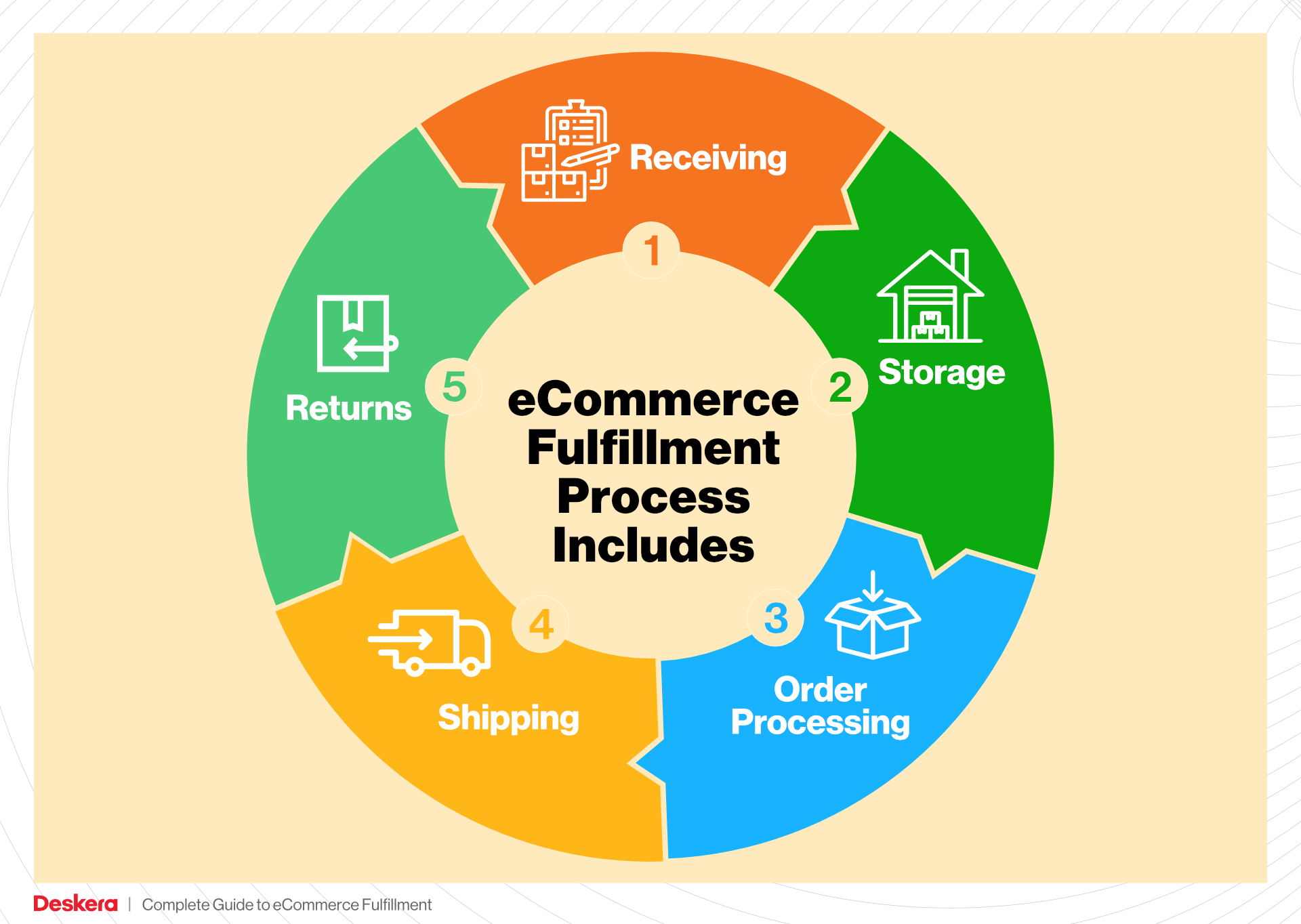
4. Order Packing
After picking, the next step is order packing, where the selected items are securely packaged for shipment. This involves choosing appropriate packaging materials, ensuring that products are protected during transit, and including necessary documentation, such as packing slips and return instructions. Automation tools can assist in this stage by providing packing guidelines based on item dimensions and weight.
Importance: Effective packing is crucial for preventing damage during shipping and ensuring that the order arrives in excellent condition. Additionally, proper packing can help reduce shipping costs by optimizing the size and weight of packages. A well-packed order not only enhances the customer experience but also reduces the likelihood of returns, which can be a significant cost to businesses.
5. Shipping & Delivery
The final step in the order fulfillment process is shipping and delivery. Once orders are packed, they are labeled and prepared for dispatch through various carriers, such as UPS, FedEx, or regional delivery services. Businesses often use tracking systems to provide customers with real-time updates on their order status, enhancing transparency and trust.
Importance: Timely shipping is a critical component of customer satisfaction. In the age of e-commerce, consumers expect fast and reliable delivery options. Businesses that can meet or exceed these expectations often see higher customer retention and loyalty rates. By leveraging data analytics for route optimization and shipping costs, companies can further improve efficiency and reduce expenses in their logistics operations.
In conclusion, the order fulfillment process is a complex yet essential aspect of e-commerce operations. By effectively managing each of these steps—receiving inventory, warehouse storage, order picking, order packing, and shipping & delivery—businesses can streamline their logistics, enhance customer satisfaction, and ultimately scale their operations successfully.
Comparing Fulfillment Models: In-House vs. 3PL vs. Dropshipping
Fulfillment Model Comparison
| Model | Who Handles Inventory | Best For (Business Stage) | Key Advantage | Key Disadvantage |
|---|---|---|---|---|
| In-House Fulfillment | Business itself | Startups to established businesses | Full control over inventory and processes | High overhead costs and resource demands |
| Third-Party Logistics (3PL) | Outsourced logistics provider | Growing businesses | Scalability and reduced operational burden | Less control over inventory management |
| Dropshipping | Supplier | Startups and entrepreneurs | Low upfront investment and risk | Low margins and reliance on suppliers |
In-House Fulfillment
In-house fulfillment refers to a model where a business manages its own inventory, storage, order processing, and shipping operations. This approach is particularly suited for startups to established businesses that have the necessary resources and desire to maintain complete control over their fulfillment process. The key advantage of in-house fulfillment is the ability to customize the process to meet specific business needs and customer expectations. This model allows businesses to closely monitor inventory levels, streamline operations, and implement quality control measures. However, it also comes with significant disadvantages, including high overhead costs associated with warehousing, staffing, and equipment. Additionally, businesses must invest time and resources in developing a logistics strategy, which can divert attention from core business activities like marketing and product development.
Third-Party Logistics (3PL)
Third-party logistics (3PL) involves outsourcing the logistics and fulfillment processes to a specialized provider. This model is ideal for growing businesses that need to scale their operations without the burden of managing logistics in-house. The primary advantage of using a 3PL provider is the ability to leverage their expertise, infrastructure, and technology, allowing businesses to focus on their core competencies. This can lead to improved efficiency, reduced shipping costs, and the ability to offer faster delivery options to customers. However, the reliance on a third-party provider can lead to a loss of control over inventory management and order fulfillment processes. Businesses may face challenges in communication and coordination, especially if the 3PL provider does not meet their specific requirements or standards. Additionally, the costs associated with 3PL services can accumulate, impacting profit margins if not carefully managed.
Dropshipping
Dropshipping is a fulfillment model where the retailer does not hold inventory but instead transfers customer orders and shipment details to a supplier, who then ships the products directly to the customer. This model is particularly attractive to startups and entrepreneurs looking to minimize upfront investment and risk, as it eliminates the need for inventory management and storage costs. The key advantage of dropshipping is its low barrier to entry, allowing businesses to quickly launch an online store without significant financial commitment. However, this model also presents challenges, including lower profit margins due to the reliance on suppliers for fulfillment and potential issues with inventory availability and product quality. Retailers must also contend with longer shipping times and less control over customer experience, which can affect brand reputation. In an increasingly competitive e-commerce landscape, businesses leveraging dropshipping must implement effective marketing and customer service strategies to mitigate these disadvantages and build customer loyalty.
Conclusion
Choosing the right fulfillment model is crucial for e-commerce success and depends on various factors, including business stage, resource availability, and customer expectations. In-house fulfillment offers complete control but at a higher cost and resource demand. Third-party logistics provide scalability and efficiency but may sacrifice some control. Dropshipping minimizes risk and upfront investment but can lead to lower profit margins and dependency on suppliers. Business owners should carefully assess their unique circumstances and growth plans to select the fulfillment strategy that aligns best with their operational goals and customer service standards.
A Deep Dive into Amazon FBA: Pros, Cons, and Who It’s For
Understanding Fulfillment by Amazon (FBA)
Fulfillment by Amazon (FBA) is a service provided by Amazon that allows sellers to store their products in Amazon’s fulfillment centers. Amazon then takes care of storage, packaging, shipping, and customer service on behalf of the seller. This service has become increasingly popular among e-commerce businesses looking to leverage Amazon’s extensive logistics network and customer base.
How FBA Works
When a seller enrolls in the FBA program, they send their products to Amazon’s fulfillment centers. Once the products are received, they are stored in Amazon’s warehouses until an order is placed. When a customer orders a product, Amazon picks, packs, and ships the item directly to the customer. The seller benefits from Amazon’s established logistics system, which includes:
- Storage: Products are stored in Amazon’s warehouses until sold.
- Order Fulfillment: Amazon handles the picking, packing, and shipping processes.
- Customer Service: Amazon provides customer service for all FBA orders, including handling returns.
- Prime Eligibility: Products fulfilled by Amazon are eligible for Amazon Prime, which can significantly increase sales.
Pros of Using FBA
Prime Eligibility
One of the most significant advantages of FBA is the eligibility for Amazon Prime. Products fulfilled through FBA are automatically available for Prime members, who expect fast and free shipping. This can lead to increased visibility and sales, as Prime members tend to shop more frequently and spend more than non-Prime members.
Customer Trust
Amazon is a trusted name in e-commerce. By using FBA, sellers can leverage Amazon’s reputation for reliability and customer service. Customers often feel more secure purchasing from sellers that use FBA due to Amazon’s robust return policy and customer service.
Multi-Channel Fulfillment
FBA allows sellers to fulfill orders from multiple sales channels, not just Amazon. This means that sellers can sell on their websites or other marketplaces while still using Amazon’s fulfillment network, which simplifies logistics and inventory management.
Scalability
FBA can help businesses scale quickly. As order volume increases, sellers don’t need to invest in additional warehouse space or staff. Amazon handles the logistics, allowing sellers to focus on growing their business.
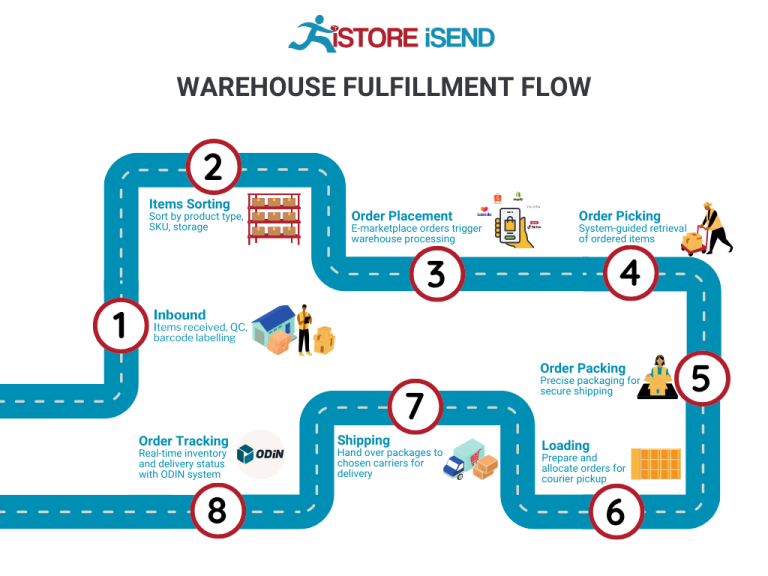
Access to Advanced Technology
Sellers using FBA benefit from Amazon’s advanced logistics technology. This includes inventory management tools, order tracking, and analytics that can help sellers optimize their business operations.
Cons of Using FBA
High Fees
FBA comes with various fees, including storage fees and fulfillment fees. These costs can add up quickly, especially for sellers with low-margin products or those who do not have high sales volumes. Sellers need to carefully consider their pricing strategy to ensure profitability while using FBA.
Strict Inventory Rules
Amazon has specific inventory management requirements that sellers must adhere to. These include restrictions on product types, packaging, and labeling. Failing to comply with these rules can result in additional fees or even account suspension.
Commingling Risks
FBA warehouses often commingle inventory from multiple sellers, meaning that the products may be mixed together. This can lead to issues where a seller’s product is shipped to a customer, but the item is damaged or defective. Sellers have less control over their inventory, which can lead to negative customer experiences and affect seller ratings.
Limited Control
While Amazon handles a lot of the logistics, sellers give up a degree of control over their operations. For instance, sellers cannot choose which fulfillment center their inventory is stored in, and they have limited visibility into the fulfillment process.
Inventory Management Challenges
Managing inventory levels can be challenging with FBA. Sellers must predict demand accurately to avoid stockouts or excess inventory, both of which can incur additional costs. Seasonal fluctuations can make this even more difficult.
Who is FBA Best For?
Fulfillment by Amazon is best suited for:
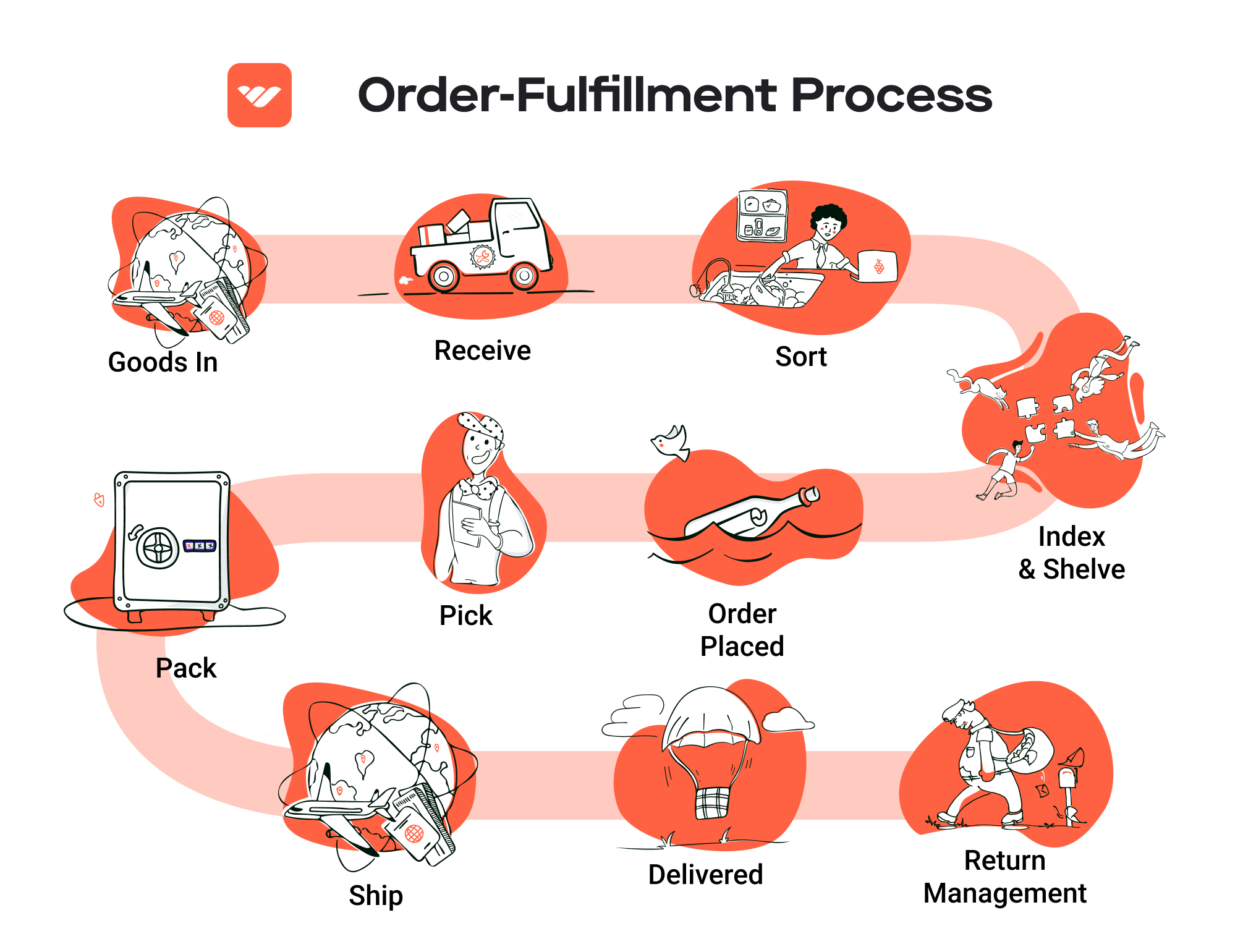
- Small to Medium-Sized Businesses: Companies looking to scale quickly without the overhead of managing their logistics can benefit from FBA’s streamlined processes.
- E-commerce Entrepreneurs: New sellers who want to enter the marketplace quickly and leverage Amazon’s infrastructure can start selling without investing in their fulfillment operations.
- High-Volume Sellers: Businesses that sell products with consistent demand and high sales volumes can offset FBA fees and maximize profits.
- Brands Seeking Prime Status: Sellers who want to increase visibility and sales through Amazon Prime can significantly benefit from using FBA.
- Multi-Channel Retailers: Companies that sell on multiple platforms can streamline their operations and inventory management by using FBA for all their orders.
In conclusion, while Fulfillment by Amazon offers numerous advantages that can help sellers scale their businesses, it also comes with challenges that need to be carefully considered. Understanding the pros and cons of FBA will enable e-commerce business owners and entrepreneurs to make informed decisions about whether it aligns with their growth strategies and operational needs.
Core Services Offered by Fulfillment Centers
Inventory Management & Warehousing
Inventory management and warehousing are foundational services provided by fulfillment centers, designed to optimize storage and control of goods. This process involves the systematic tracking of inventory levels, orders, sales, and deliveries. Fulfillment centers use advanced Warehouse Management Systems (WMS) to automate these tasks, ensuring that businesses have real-time visibility into their stock.
Benefits:
-
Enhanced Accuracy: Automated systems reduce human error, ensuring that inventory counts are precise and up-to-date. This accuracy minimizes the risk of stockouts or overstock situations, which can significantly impact cash flow and customer satisfaction.
-
Space Optimization: Fulfillment centers utilize sophisticated storage solutions, including racking systems and vertical storage, to maximize warehouse space. This allows e-commerce businesses to store more products without incurring additional costs.
-
Improved Forecasting: By analyzing inventory turnover rates and sales data, fulfillment centers can help businesses predict future demand more accurately. This insight enables better decision-making regarding restocking and inventory levels, ultimately leading to reduced holding costs.
-
Scalability: As e-commerce businesses grow, their inventory needs can change rapidly. Fulfillment centers provide scalable warehousing solutions that allow businesses to adjust their storage capacity based on seasonal demand or unexpected spikes in sales.
Pick and Pack Services
Pick and pack services are crucial for efficiently fulfilling customer orders. This process involves selecting the ordered items from inventory (picking) and then packaging them appropriately for shipment (packing). Fulfillment centers typically employ streamlined processes and technology to ensure that this service is both quick and accurate.
Benefits:
-
Speed of Fulfillment: With dedicated staff and optimized processes, fulfillment centers can significantly reduce the time it takes to pick and pack orders. Fast fulfillment is essential in the competitive e-commerce landscape, where customers increasingly expect same-day or next-day delivery.
-
Customization Options: Many fulfillment centers offer customizable packaging solutions, allowing businesses to enhance their branding through personalized packaging. This can improve the customer experience and foster brand loyalty.
-
Error Reduction: Advanced picking technologies, such as barcode scanning and automated picking systems, help minimize errors during the picking process. Fewer mistakes lead to higher customer satisfaction and lower return rates.
-
Cost Efficiency: By outsourcing pick and pack operations, e-commerce businesses can save on labor and overhead costs. Fulfillment centers can leverage economies of scale to offer competitive pricing for these services.
Kitting and Assembly
Kitting and assembly are specialized services that involve combining individual items into a single, ready-to-ship unit. This can include assembling products, creating bundles, or packaging promotional items together. Fulfillment centers equipped for kitting and assembly can streamline this process, ensuring that products are prepared for sale in an efficient manner.
Benefits:
-
Enhanced Customer Offerings: Kitting allows businesses to create unique product bundles or promotional sets that can attract customers. This strategy can increase average order values and enhance the overall shopping experience.
-
Time Savings: Outsourcing kitting and assembly to fulfillment centers can free up valuable time and resources for e-commerce businesses. Rather than dedicating internal resources to these tasks, businesses can focus on core operations such as marketing and product development.
-
Improved Quality Control: Fulfillment centers often have rigorous quality control processes in place. This ensures that assembled products meet established standards, reducing the likelihood of returns due to faulty items.
-
Flexible Solutions: Whether a business needs seasonal kits or ongoing assembly for a new product line, fulfillment centers can adapt to changing needs. This flexibility is crucial for maintaining responsiveness to market trends.
Returns Management (Reverse Logistics)
Returns management, also known as reverse logistics, is a critical service offered by fulfillment centers that facilitates the return process for customers. This service includes processing returns, restocking items, and managing the resale of returned products. Efficient returns management can significantly impact customer satisfaction and operational efficiency.
Benefits:
-
Streamlined Returns Process: Fulfillment centers can handle returns quickly and efficiently, providing customers with a hassle-free experience. A smooth return process can enhance customer loyalty and encourage repeat business.
-
Data Insights: By analyzing return data, fulfillment centers can help businesses identify patterns in returns, such as common issues with specific products. This information can inform product development and quality assurance efforts.
-
Cost Reduction: Efficient returns management can minimize the costs associated with handling returns. Fulfillment centers optimize the process to ensure that returned items are quickly restocked or disposed of as necessary, reducing waste and lost revenue.
-
Inventory Recovery: Many fulfillment centers offer services to refurbish or resell returned items. This capability can help businesses recover value from returned products, reducing overall losses.
By leveraging these core services, e-commerce businesses can enhance their operational efficiency, improve customer satisfaction, and ultimately scale their operations effectively. Partnering with a capable fulfillment center allows businesses to focus on growth while ensuring their logistics and fulfillment processes are in expert hands.
How to Choose a Fulfillment Partner: A 6-Point Checklist
Location & Warehouse Network
Why It’s Important:
The geographical location of your fulfillment partner’s warehouses plays a crucial role in your logistics efficiency. Proximity to your customer base can significantly reduce shipping times and costs, enhancing the overall customer experience.
Questions to Ask:
1. Where are your warehouses located, and how many do you operate?
2. Can you provide insights into your delivery reach and any regional advantages?
3. How do you handle last-mile delivery, and what carriers do you partner with?
4. Are there plans for expanding your network in the near future?
Technology & Integrations
Why It’s Important:
A robust technology platform that integrates seamlessly with your e-commerce system is vital for efficient operations. It allows for real-time inventory tracking, order management, and data analytics, which can help you make informed decisions and improve operational efficiency.
Questions to Ask:
1. What warehouse management system (WMS) do you use, and how does it integrate with e-commerce platforms like Shopify or WooCommerce?
2. Can you provide real-time tracking for orders and inventory levels?
3. Do you offer APIs for custom integrations with our existing systems?
4. How do you ensure data security and compliance with regulations?
Specializations (e.g., Cold Storage, Oversized Items)
Why It’s Important:
Different products require different storage and handling procedures. If your business deals with specialized items like perishables or oversized goods, it’s essential to partner with a fulfillment center that has the necessary facilities and expertise.
Questions to Ask:
1. What types of special storage facilities do you offer (e.g., cold storage, hazardous materials)?
2. Can you handle oversized or heavy items, and what are the associated costs?
3. What certifications do you hold for specialized storage and handling?
4. How do you manage inventory for specialized products to ensure quality and compliance?
Scalability & Capacity
Why It’s Important:
As your business grows, your fulfillment needs will likely change. A fulfillment partner should not only meet your current requirements but also have the capacity and flexibility to scale operations as your business expands.
Questions to Ask:
1. How do you handle fluctuations in order volume, such as during peak seasons?
2. What is your current capacity, and how quickly can you scale if our order volume increases?
3. Do you have a history of successfully scaling operations for other clients?
4. How do you manage inventory levels during periods of rapid growth or seasonal spikes?
Pricing and Contracts
Why It’s Important:
Understanding the pricing structure and contract terms is vital to ensure that you can maintain healthy profit margins. Transparent pricing helps you avoid unexpected costs that could arise from hidden fees or unfavorable contract terms.
Questions to Ask:
1. Can you provide a detailed breakdown of your pricing model, including storage, pick and pack, and shipping fees?
2. Are there any additional costs we should be aware of (e.g., returns processing, long-term storage)?
3. What are the terms of your contracts, and how flexible are they?
4. How do you handle pricing adjustments in response to changes in our order volume or service requirements?
Customer Support & Reviews
Why It’s Important:
Effective customer support can make a significant difference in resolving issues quickly and maintaining operational efficiency. Additionally, checking reviews and testimonials can provide insights into the partner’s reliability and service quality.
Questions to Ask:
1. What customer support options do you offer (e.g., phone, email, chat), and what are your hours of availability?
2. How quickly can we expect a response to inquiries or issues that arise?
3. Can you provide references or case studies from clients in our industry?
4. What measures do you take to ensure high levels of customer satisfaction?
Conclusion
Selecting the right fulfillment partner is a critical decision that can greatly impact your business’s scalability and operational efficiency. By utilizing this checklist, you can systematically evaluate potential partners and choose one that aligns with your business goals and customer expectations. Prioritize open communication and transparency throughout the selection process to ensure a successful partnership that can adapt as your business evolves.
Understanding Fulfillment Pricing: A Breakdown of Common Fees
Initial Setup Fees
When partnering with a fulfillment center like Amazon’s KRB6, the initial setup fees are often the first cost to consider. These fees typically cover the establishment of your account, integration with your e-commerce platform, and any necessary onboarding processes. The amount can vary based on the complexity of your operations and the level of customization required.
For example, if you need to integrate specific inventory management software or set up unique shipping rules, the initial setup fee may increase. To calculate these fees, fulfillment centers assess your business needs and may charge a flat fee or an hourly rate based on the time spent setting up your account. It’s crucial to clarify what is included in these fees to avoid unexpected costs later.
Receiving Fees
Receiving fees are charged when your inventory arrives at the fulfillment center. These costs cover the labor and processes involved in unloading, inspecting, and storing your products. Typically, receiving fees can be calculated per pallet or per item, depending on how your inventory is packaged and shipped.
For instance, if you send a large shipment of products in bulk, you might pay a lower rate per pallet than if you send many small individual items. Fulfillment centers will charge based on the volume of goods received, and additional costs may apply if your inventory requires special handling, such as temperature control or fragile item management.
Storage Fees (per pallet/bin)
Storage fees are incurred for the time your inventory is held at the fulfillment center. These fees are usually calculated on a monthly basis and can vary depending on whether you choose to rent space by the pallet or by the bin.
For example, if you have a high turnover of inventory, you may opt for pallet storage, which is often less expensive. In contrast, if your products are smaller and stored in bins, the fees may be calculated based on the number of bins occupied. Additionally, some fulfillment centers implement tiered pricing structures where the cost per pallet decreases as you store larger quantities. It’s important to understand how long you plan to store items and the associated costs, as prolonged storage can significantly impact your overall fulfillment expenses.
Pick & Pack Fees (per item/order)
Pick and pack fees are charged for the process of selecting items from your inventory and preparing them for shipment. This fee can be structured in several ways, including a flat fee per order or a fee based on the number of items picked.
For instance, if a customer places an order for three different items, the fulfillment center may charge a fee for picking each item plus a flat fee for packing the order. The complexity of the order can also affect costs; for example, custom packaging requirements may incur additional fees. To manage these costs, businesses should aim to streamline their inventory and order fulfillment processes, reducing the number of items in each order wherever possible.
Shipping Fees
Shipping fees represent one of the most variable components of fulfillment pricing. These fees are determined by several factors, including the weight and dimensions of the package, the shipping method selected (standard, expedited, etc.), and the destination. Fulfillment centers often negotiate shipping rates with carriers, which can lead to cost savings for businesses.
To calculate shipping fees, fulfillment centers typically use dimensional weight pricing, which considers both the weight and size of the package. Businesses should also be aware of additional charges that may arise, such as fuel surcharges or handling fees for oversized items. Understanding the shipping options available and the associated costs will help you budget more effectively for fulfillment.
Tips for Getting an Accurate Quote
-
Be Clear About Your Needs: Provide detailed information about your inventory, expected order volume, and specific requirements (such as special handling) to get a more accurate quote.
-
Request a Breakdown of Fees: Ask the fulfillment center for a detailed breakdown of all potential fees. This transparency will help you understand the cost structure and identify areas for potential savings.
-
Consider Seasonal Variations: If your business has seasonal fluctuations, inquire about how these might affect your fees, particularly storage and shipping costs.
-
Negotiate Terms: Don’t hesitate to negotiate terms and pricing, especially if you expect to scale your operations significantly. Many fulfillment centers are open to adjusting fees based on volume commitments.
-
Compare Multiple Providers: Get quotes from several fulfillment centers to compare costs and services. This will give you a better perspective on the market rates and help you make an informed decision.
By understanding these common fulfillment pricing models, e-commerce business owners can better prepare for the financial aspects of scaling their operations and ensure they choose a fulfillment strategy that aligns with their business goals.
Frequently Asked Questions (FAQs) about Fulfillment
1. What is the Amazon Fulfillment Center KRB6?
The Amazon Fulfillment Center KRB6 is a specialized facility located at 4200 Ferry Rd, Aurora, IL. It plays a crucial role in Amazon’s extensive logistics network, focusing on storing, processing, and shipping products directly to customers. This center operates 24/7 to meet the high demand for rapid delivery and ensure that customer orders are fulfilled efficiently.
2. What services does Amazon Fulfillment Center KRB6 offer?
KRB6 offers a variety of services, including receiving inventory, storage, order picking, packing, and shipping. The center is equipped to handle large volumes of products, ensuring that they are processed quickly and shipped directly to customers, thus enhancing the overall customer experience.
3. How does KRB6 differ from a traditional warehouse?
While both KRB6 and traditional warehouses store products, a fulfillment center like KRB6 is specifically designed for faster order processing and shipping directly to customers. In contrast, traditional warehouses typically focus on long-term storage and may not prioritize immediate order fulfillment. Fulfillment centers utilize advanced technology and logistics strategies to minimize shipping times and costs.
4. What is a 3PL, and how does it relate to Amazon fulfillment?
A 3PL, or third-party logistics provider, is a company that manages logistics and distribution for other businesses. Amazon’s fulfillment centers, including KRB6, can be considered a form of 3PL service, as they handle storage, order processing, and shipping for sellers using Amazon’s platform. This allows e-commerce businesses to leverage Amazon’s extensive logistics network without managing their own fulfillment operations.
5. How much do fulfillment services cost?
The cost of fulfillment services can vary widely based on several factors, including the volume of orders, the types of products, and the specific services required. Typically, fulfillment costs include storage fees, picking and packing fees, and shipping costs. For Amazon Fulfillment Center KRB6, sellers can find detailed pricing on the Amazon Seller Central platform, which offers insights into the fees associated with using their fulfillment services.
6. What are the benefits of using the Amazon Fulfillment Center KRB6 for my business?
Utilizing KRB6 can provide several benefits, including faster shipping times, reduced shipping costs, and improved customer satisfaction due to reliable order fulfillment. Additionally, businesses can scale operations without investing in their own warehousing and logistics infrastructure, allowing them to focus on growth and customer engagement.
7. What types of products are suitable for fulfillment at KRB6?
KRB6 is equipped to handle a wide range of products, from small consumer electronics to larger household items. However, sellers should ensure that their products comply with Amazon’s policies and guidelines. It’s advisable to review the specific category restrictions and requirements on the Amazon Seller Central platform.
8. How can I track my orders fulfilled by KRB6?
Sellers can track their orders through the Amazon Seller Central dashboard, which provides real-time updates on order status, shipping progress, and delivery confirmations. Additionally, customers can track their orders using tracking numbers provided by Amazon once the orders are shipped.
9. What should I do if there are issues with my fulfillment orders at KRB6?
If you encounter issues with your fulfillment orders, such as missing items or shipping delays, it is essential to contact Amazon Seller Support immediately. They can assist in resolving fulfillment-related problems and provide guidance on best practices to prevent future issues.
10. How does KRB6 handle returns and customer service?
Amazon Fulfillment Center KRB6 has established processes for managing returns efficiently. When a customer returns a product, it is processed back through the fulfillment center, where it can either be restocked or disposed of according to Amazon’s policies. Customer service for fulfillment-related inquiries is typically handled through Amazon’s customer support channels, ensuring that customers receive timely assistance.
By leveraging the capabilities of the Amazon Fulfillment Center KRB6, e-commerce businesses can enhance their logistics operations, streamline order processing, and ultimately improve customer satisfaction.
Conclusion: Is Outsourcing Fulfillment the Right Move for Your Business?
Benefits of Outsourcing Fulfillment
Outsourcing fulfillment can be a game-changer for e-commerce businesses aiming to scale. One of the most significant advantages is time savings. By entrusting the logistics of order processing, inventory management, and shipping to a fulfillment partner, you free up valuable time that can be redirected towards core business activities such as product development, marketing, and customer engagement. This shift allows you to focus on strategic growth rather than getting bogged down in operational details.
Scalability is another compelling reason to consider outsourcing. As your business grows, so do the complexities of managing inventory and fulfilling orders. A fulfillment partner can seamlessly scale operations to match your business demands, whether you experience seasonal spikes or steady growth. This flexibility ensures that you can meet customer expectations for rapid delivery without compromising service quality.
Moreover, partnering with an experienced fulfillment provider brings a wealth of expertise to your operations. These providers often employ skilled personnel and advanced technology to optimize inventory management, reduce shipping costs, and enhance customer satisfaction. Their specialized knowledge can help minimize errors and improve efficiency, ultimately contributing to a better bottom line.
Choosing the Right Partner
However, it’s crucial to select the right fulfillment partner to align with your business objectives. Not all providers offer the same level of service, technology, or scalability. Conduct thorough research and consider factors such as their location, technology stack, and customer service track record to ensure they can support your growth.
Call to Action
To determine if outsourcing fulfillment is the right move for your business, conduct a comprehensive audit of your current shipping processes. Evaluate your operational bottlenecks, shipping costs, and customer feedback. This assessment will help clarify whether a fulfillment partner could enhance your efficiency, scalability, and overall customer satisfaction. By taking this strategic step, you can position your business for sustained growth in the competitive e-commerce landscape.
Important Disclaimer
⚠️ Important Disclaimer
The information in this guide is for educational purposes. Fulfillment services, pricing, and platform features change frequently. Always conduct your own due diligence and consult with providers directly before making business decisions.
